Jackal, a canine animal, inhabits everywhere, from deserts to savannas and from the mountains to the woodlands. They are opportunistic omnivores but love to devour flesh.
Also, they are loyal to their partners and mate only with them for a lifetime. There is a lot to know about them, and this article will enrich your knowledge regarding their history, ecology, behavior, and reproduction.
So, what are you waiting for? Hop on and get to know everything related to the jackals.
Etymology
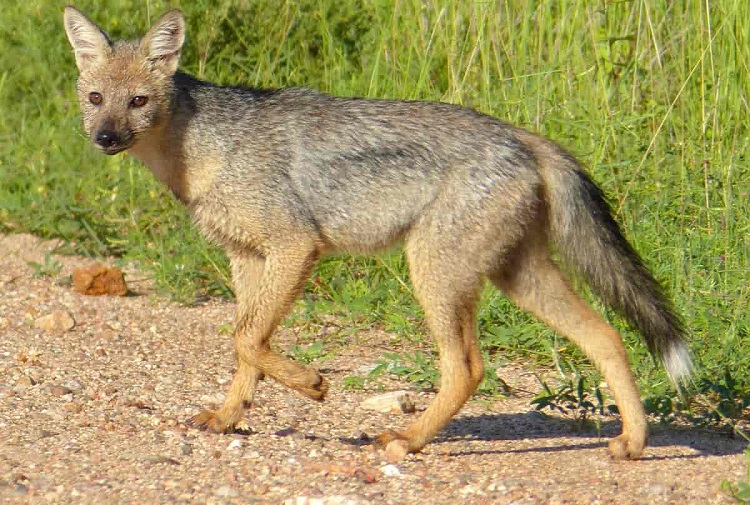
The word jackal comes from the French Chachal, which emerged in C. 1600. Its origin also connects with the cakal in the Turkish language and the shaghal of Persian. In Sanskrit, it’s Sragala, which means the howler.
The scientific name of this animal is CANIS AUREUS, while the black-backed jackal is called CANIS MESOMELAS, scientifically!
You would be amazed to know that in the general informal vocabulary used by humans, the word jackal is used for a person who is opportunistic and is always thinking about his own benefit over the cost of others.
Jackals Natural History
Currently, you would see most of the jackals living in Africa. However, over their extensive history, they have had the experience of residing in various places across the globe.
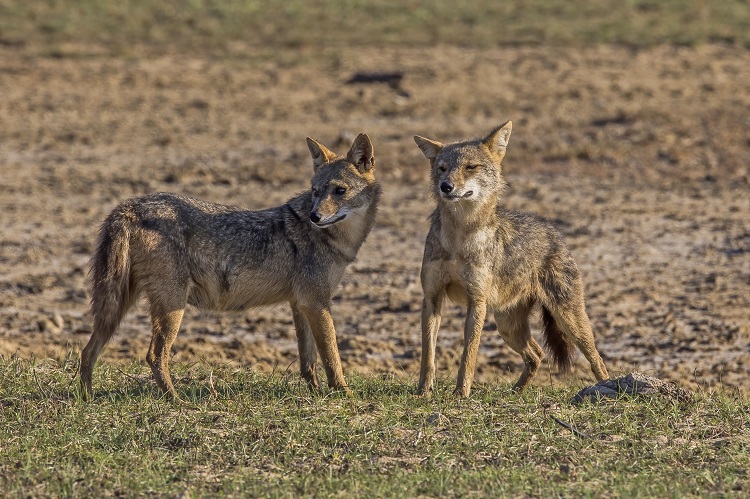
New Fossils Depict a Rich History
The recently found fossil remains have dawned upon humans that some species of this animal actually date back to around 5 million years ago. This means that Eucyon Davisi, which lives in North America, is not really the natural ancestor of jackals. The fossil found in South Africa showcases a rather older history!
The earliest species of the jackal, Canis Arnensis, residing in Mediterranian Europe, has now gone extinct. It looked like a small jackal infused into a dog. The fossils of the oldest golden jackal have been found in Greece and Europe.
Genetic diversity in modern jackals is quite vast. Currently, the most common inhabitance of the golden jackal is Africa, while the black-backed jackal prefers locating in Southern Africa.
Species
Jackals are a prominent part of the Canidae family, and they have three species in total. They are named; the Black-backed jackal, Golden jackal, and Side striped jackal. Each of these species comes with a distinct set of characteristics that sets it apart from others.
The African golden wolf is actually the Golden Jackal but it is its African variant. It has one sub-species called C.a.lupaster. This subspecies has now been classified as an actual wolf. Capable of creating hybrid offspring, it is pretty close to the coyotes.
The Black-backed Jackal; With the Strongest Jaws
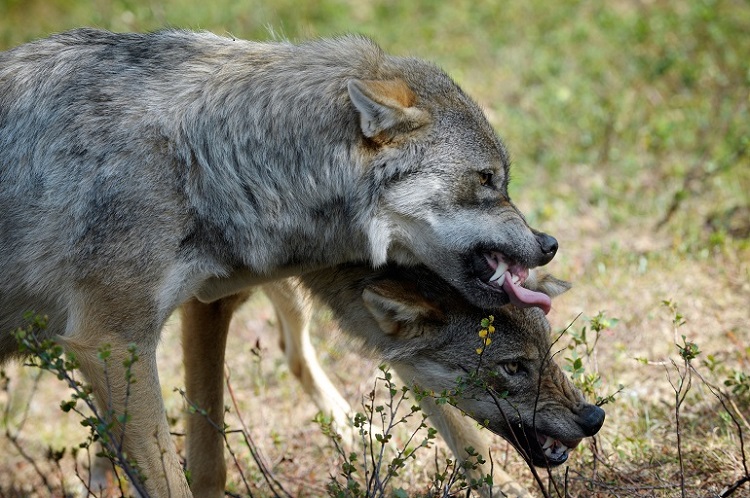
The species that one can easily recognize is the black-backed jackal. This is owing to the distinctive appearance that sets it apart from others. With gold fur spreading across their back and a silver strip through the posterior surface, they are easily spotted.
Being super brave and having the strongest jaws, they can even fight off hyenas residing in the same place in Africa.
The Side Striped Jackal; Easily Noticeable
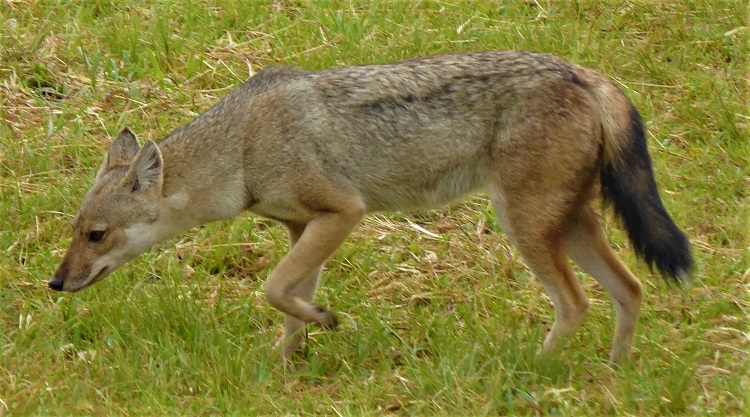
Comparatively, the side-striped jackal, as the name signifies, has stripes of various colors on the sides! You would find it walking around the forests or woodlands, as it loves expansive spaces. Mostly, Africa is where most of the side-striped jackals inhabit.
The Golden Jackal; The Most Common One!
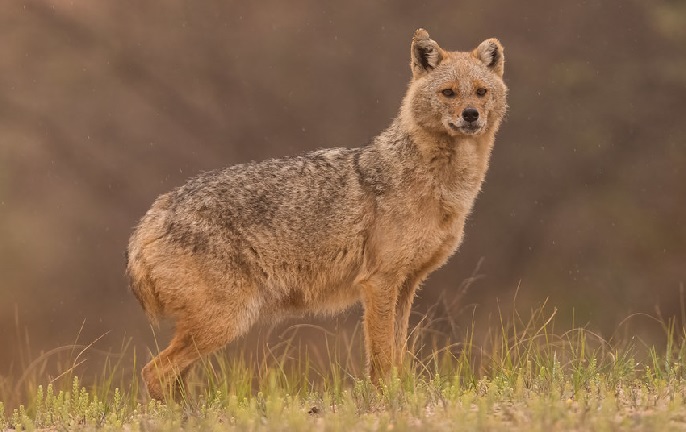
The most common of them all is the golden jackal. This is probably the reason its other name is ‘common jackal’. Also known as canis aureus, its coat showcases a tannish gold appearance, while the inner side is brownish.
They are spread all across the globe, while they mostly like staying in Asia, Europe, and Africa. As a matter of fact, these jackals living in varied locations display some differences, despite being part of the same species. Hence, a lot of researchers actually consider canis aureus to be the subspecies of jackals.
As it’s mostly found in eastern Africa, it’s also termed the African jackal!
Jackal Appearance
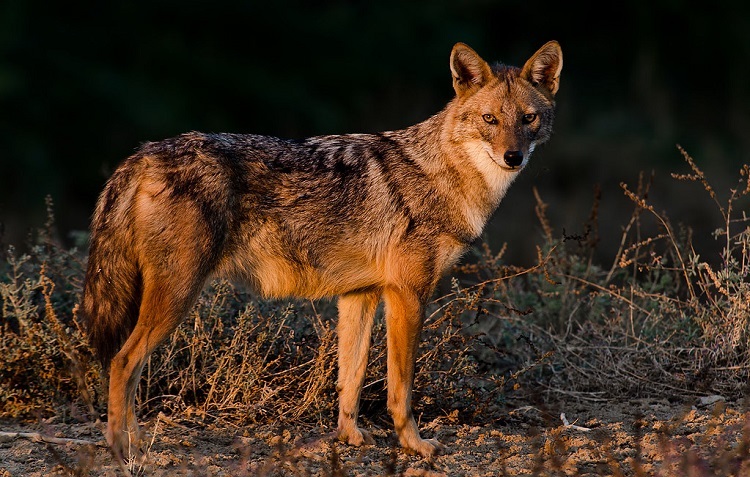
Jackal is not a very massive animal. Rather, it can be described as a small to a medium-sized creature. With a body length of around eighty centimeters and a body mass of somewhere close to twenty to thirty pounds, it’s easily identifiable from afar.
Thanks to the wide feet of all three species, jackals can easily run longer distances with an impressive speed. Their long legs also aid them in their efficiency.
Where the Black-backed jackal appears slender, the common jackal is shorter and a bit bulky in appearance. Also, jackals have pretty sharp eyes that glee in the dark, which makes it easier for humans to identify them. In terms of appearance, they are closely related to wolves.
Jackal Ecology and Habitat
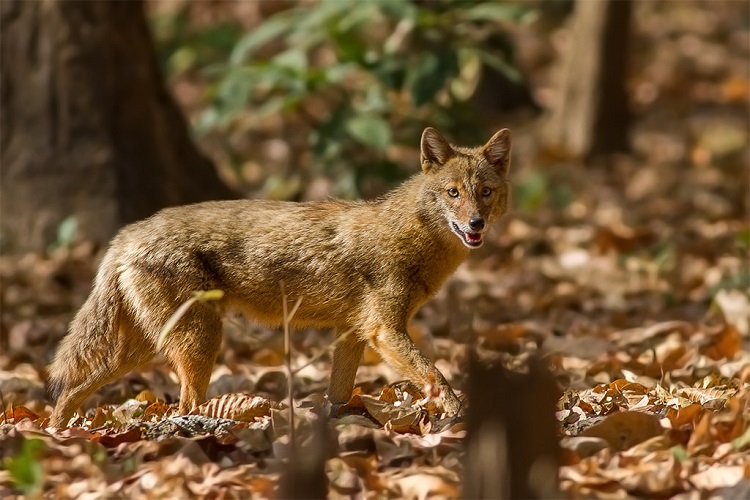
Jackals are of great importance in terms of ecology. Most ecologists consider them as one of the most significant cleaners living on the planet Earth. They aid humans in waste management, relieving them of a lot of stress and workload.
Jackals are one of those mammal carnivores who help in maintaining biodiversity. They also ensure the stability of the ecosystem to the maximum. The golden jackals are especially of great significance as they scavenge and look for waste and dead animals. By consuming them, they help the environment get cleaner.
Alongside this, a major portion of the diet of these animals residing along human settlements is the rodents. These rodents that affect human crops are consumed by large carnivores, such as jackals, helping the farmers protect their crops.
Having said that, another aspect of these three species is that of being predators of smaller animals. In the quest to fill up their stomachs, they end up killing some species that are already endangered, leading them to extinction.
Also, they monopolize vital natural and territorial resources, leaving other members of the habitat at a loss.
At times, they also end up attacking the sheep, which is why most farmers keep their fields shielded through fences.
As this animal is closely related to the dog, there are studies that show it is a major contributor to the spread of rabies.
Claims by the African Wildlife Foundation
Deserts, grasslands, and savannas are the favorite places for the jackals to reside. According to the African wildlife foundation, mountains and marshes of Africa are also some prominent spots where one can find jackals.
Jackals live in varied habitats. This feature of the mammal resembles that of foxes, which is why you would see jackals being widespread across the globe. If you ask for one possible place where the side-striped jackal lives, it would be moist savannas and arid grasslands.
Grassy plains offer them enough space to move around. At the same time, there are certain species, like African hunting dogs who prefer living in suburbs. This is why they come in contact with humans a bit too often. Being close to the human settlements, they interact with them quite a lot!
The North American region has a lot of coyotes residing there. You would see them quite often in Canada as well. Comparatively, the golden rascal prefers staying in the Middle Eastern and European regions. Black backs are everywhere in Africa.
Generally, the side-striped jackals prefer living in the valleys that connect with the rivers or have some seashores around them. Its presence around low mountains is quite rare! Black-backed jackals, however can be found in the coastal areas as well as in the deserts!
Jackal Behavior
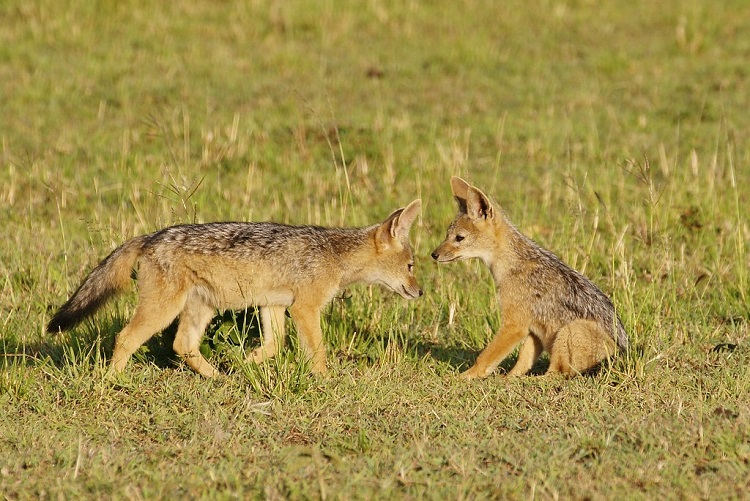
That one word that best describes the behavior of the jackals is crepuscular. This means that they are active right from dawn to dusk. Hence, whenever you would come across them, you would always find them running at the greatest speed possible.
Where most jackals prefer living singularly, you would see their packs as well. While living in packs, their behavior is quite closely synchronized.
You would be amazed to know that this animal is pretty adaptable. Contrary to the generic concept, it’s not aggressive when comes in contact with larger mammals and mostly avoids human interaction.
Also, they are nocturnal as well as diurnal, which means they are active throughout the day and love staying awake through the night as well.
During the time they are active, they keep looking for food continuously. Mostly, jackals live with their partners and have specific partners for their whole life. One can say that they surely are keepers!
Amongst all the species of jackals, the black-backed jackals are surely the friendliest ones and prefer living in a family group. Being territorial animals, their loyalty towards their territory is quite high! At times, they would aggressively come into a fight to defend a particular territory.
They are also pretty good communicators. They talk to each other in the form of howling and growling. Well, to humans, this woofing and yelping could be soul-chilling, but it’s pretty normal for them!
Opportunistic Omnivores While Hunting
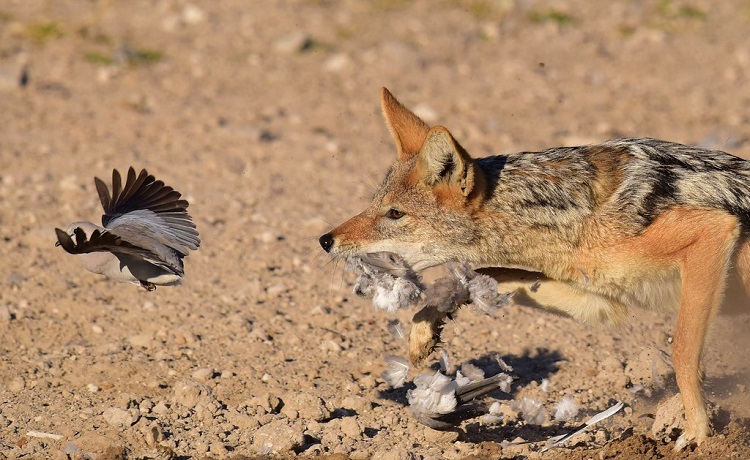
The jackal is an opportunistic omnivore, as mentioned before. This means that they are highly cooperative with each other when it comes to hunting. Most of the time, they follow larger carnivores and pick through their kills. To find their remains, they would even check out the leftover mess and rubbish.
They mainly hunt reptiles, birds flying low on the ground, berries, grass, insects, and fruits. Hence, they have a varied menu to pick up from and can easily fill their bellies up. When they can’t hunt and eat reptiles, they look for the leftovers of other carnivores.
How Strong Is a Jackal’s Bite?
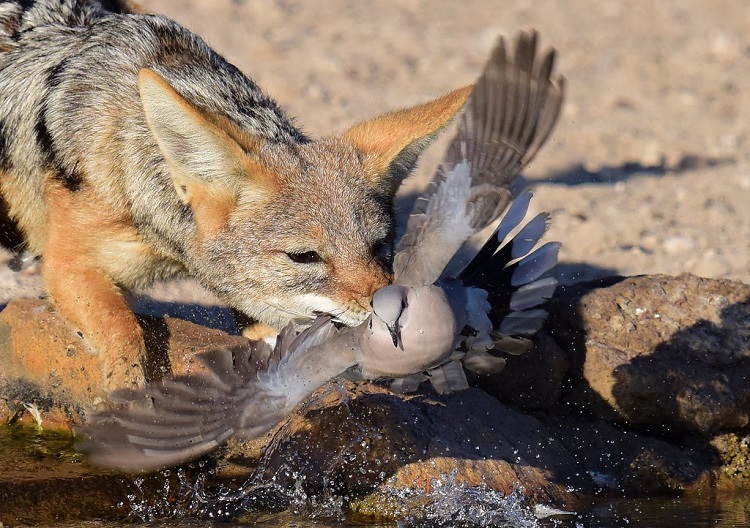
When compared to the other members of the canine family, the bite of a jackal is not very strong. Actually, it’s much weaker than the mountain lion. The bite force is around 776 pounds per square inch, whereas a tiger’s bite is around 1050 psi.
In terms of physical characteristics, the teeth of this animal are pretty sharp, while the jaws are quite strong. Hence, even if the bite is not as strong as that of the other canine animals, it can still hurt humans pretty badly.
At the same time, some reports have shown them being a cause of rabies in animals and humans. Though it’s not very common, there have been some reports in the past of this happening.
Being opportunistic omnivores, when one jackal finds prey, others jump in to help him begin the chase and kill it. Those jackals who are always in pairs frequently find their prey together, even if that means finding an already killed animal from the nearby trash.
Jackal Reproduction, Babies, and Lifespan
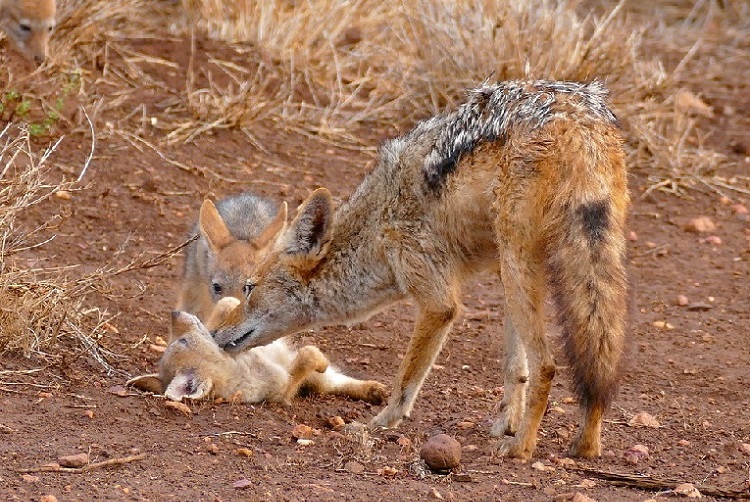
Jackals have a monogamous relationship in which the pairs are already defined. This means that throughout life, jackals keep only one partner and are pretty loyal to each other.
Also, they are pretty possessive! Together with his partner, a male jackal lives within a territory and defends it fearlessly when needed. It also makes sure no random male jackal gets to intrude on their privacy.
The start of January initiates the breeding season in jackals, and it extends all the way till February. This mating season is around a month-long, and after that, there is a gestation period of sixty-three days. Then, the mother gives birth to two to four offspring in a single go.
The pups are small, adorable kiddos of these jackals who are weaned for as long as eight weeks. After that, they start growing their reproductive parts and become regular members of the jackal family.
Family values are pretty strong in this animal. The partners mate for life and then make pups to continue the tradition. The pups that the mother litters stay with the parents and aid them in bringing up their offspring.
Its lifespan is around eight to ten years! However, that’s based on the fact that predators and hunters don’t get to succeed in their chase, ever. If they do, obviously this life span would reduce automatically.
Jackals Vs. Coyotes
Though jackals and coyotes appear pretty similar, there are great differences between these two. In terms of appearance, coyotes are not only bigger in size but also have longer and sharper teeth.
While coyotes mostly prefer residing in the Northern American region, you would see jackals in a huge number in Africa. In a fight between these two, the coyotes have an edge of being bigger and having sharper teeth, but it’s actually the jackal with a stronger bite!
Do Jackals Eat Humans?
Jackals scavenge to find their prey and mostly look for small-sized animals to fill their bellies. They certainly don’t eat humans!
Being opportunistic predators, they are more likely to eat whatever comes their way, be it a small animal or a delicious fruit.
Having said that, it’s also true that they may attack any human that could be wandering within their territory. This is mainly to defend their living space and avoid invasion.
Jackal Conservation Status
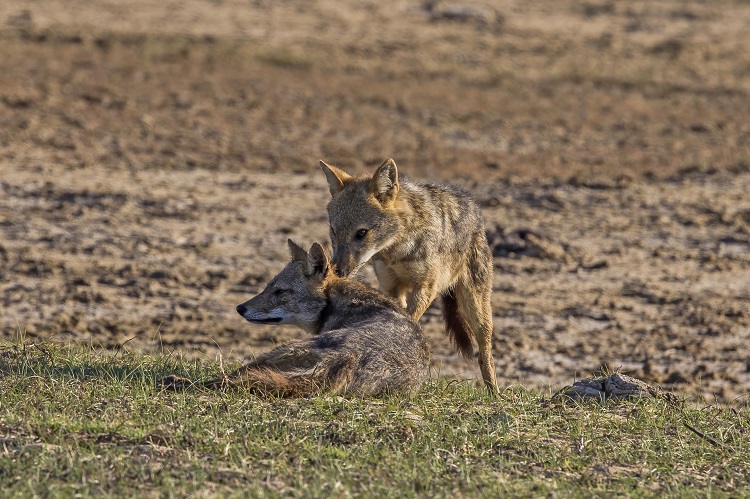
Jackal conservation status is ‘least concerned’. They are not endangered, and humans don’t need to worry about them going extinct! As a matter of fact, as they are widespread across the globe, they can easily be spotted anywhere and at any time!
Even in the Indian continent, the golden jackal is the most widely spread canine animal.
However, if they end up facing issues like habitat loss and increased hinting, they may be recognized as ‘concerned’. However, currently, that’s not the case!
Conclusion
Jackals are prominent members of the canide family and are closely related to dogs and wolves. These mammals are excellent breeders and mate for life!
When out in the wild without any significant danger, they may live as long as eight to ten years.
Being cleaners of the environment as well as predators, these mammals are pretty interesting and keep a healthy balance in the ecosystem.
Did you enjoy learning about these gorgeous animals? Let us know if you have something more to share with us!


